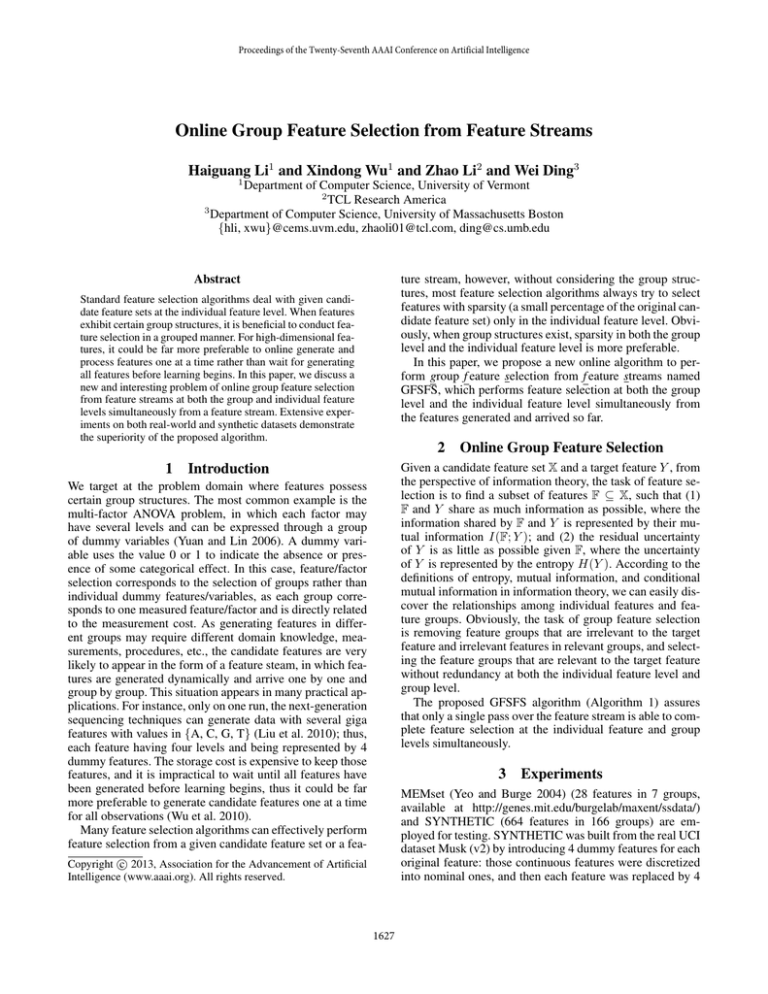
Proceedings of the Twenty-Seventh AAAI Conference on Artificial Intelligence
Online Group Feature Selection from Feature Streams
Haiguang Li1 and Xindong Wu1 and Zhao Li2 and Wei Ding3
1
Department of Computer Science, University of Vermont
2
TCL Research America
3
Department of Computer Science, University of Massachusetts Boston
{hli, xwu}@cems.uvm.edu, zhaoli01@tcl.com, ding@cs.umb.edu
Abstract
ture stream, however, without considering the group structures, most feature selection algorithms always try to select
features with sparsity (a small percentage of the original candidate feature set) only in the individual feature level. Obviously, when group structures exist, sparsity in both the group
level and the individual feature level is more preferable.
In this paper, we propose a new online algorithm to perform group f eature selection from f eature streams named
GFSFS, which performs feature selection at both the group
level and the individual feature level simultaneously from
the features generated and arrived so far.
Standard feature selection algorithms deal with given candidate feature sets at the individual feature level. When features
exhibit certain group structures, it is beneficial to conduct feature selection in a grouped manner. For high-dimensional features, it could be far more preferable to online generate and
process features one at a time rather than wait for generating
all features before learning begins. In this paper, we discuss a
new and interesting problem of online group feature selection
from feature streams at both the group and individual feature
levels simultaneously from a feature stream. Extensive experiments on both real-world and synthetic datasets demonstrate
the superiority of the proposed algorithm.
1
2
Introduction
Online Group Feature Selection
Given a candidate feature set X and a target feature Y , from
the perspective of information theory, the task of feature selection is to find a subset of features F ⊆ X, such that (1)
F and Y share as much information as possible, where the
information shared by F and Y is represented by their mutual information I(F; Y ); and (2) the residual uncertainty
of Y is as little as possible given F, where the uncertainty
of Y is represented by the entropy H(Y ). According to the
definitions of entropy, mutual information, and conditional
mutual information in information theory, we can easily discover the relationships among individual features and feature groups. Obviously, the task of group feature selection
is removing feature groups that are irrelevant to the target
feature and irrelevant features in relevant groups, and selecting the feature groups that are relevant to the target feature
without redundancy at both the individual feature level and
group level.
The proposed GFSFS algorithm (Algorithm 1) assures
that only a single pass over the feature stream is able to complete feature selection at the individual feature and group
levels simultaneously.
We target at the problem domain where features possess
certain group structures. The most common example is the
multi-factor ANOVA problem, in which each factor may
have several levels and can be expressed through a group
of dummy variables (Yuan and Lin 2006). A dummy variable uses the value 0 or 1 to indicate the absence or presence of some categorical effect. In this case, feature/factor
selection corresponds to the selection of groups rather than
individual dummy features/variables, as each group corresponds to one measured feature/factor and is directly related
to the measurement cost. As generating features in different groups may require different domain knowledge, measurements, procedures, etc., the candidate features are very
likely to appear in the form of a feature steam, in which features are generated dynamically and arrive one by one and
group by group. This situation appears in many practical applications. For instance, only on one run, the next-generation
sequencing techniques can generate data with several giga
features with values in {A, C, G, T} (Liu et al. 2010); thus,
each feature having four levels and being represented by 4
dummy features. The storage cost is expensive to keep those
features, and it is impractical to wait until all features have
been generated before learning begins, thus it could be far
more preferable to generate candidate features one at a time
for all observations (Wu et al. 2010).
Many feature selection algorithms can effectively perform
feature selection from a given candidate feature set or a fea-
3
Experiments
MEMset (Yeo and Burge 2004) (28 features in 7 groups,
available at http://genes.mit.edu/burgelab/maxent/ssdata/)
and SYNTHETIC (664 features in 166 groups) are employed for testing. SYNTHETIC was built from the real UCI
dataset Musk (v2) by introducing 4 dummy features for each
original feature: those continuous features were discretized
into nominal ones, and then each feature was replaced by 4
c 2013, Association for the Advancement of Artificial
Copyright Intelligence (www.aaai.org). All rights reserved.
1627
Algorithm 1 GFSFS:group feature selection from feature streams
1: repeat
2:
repeat
3:
Get the new arrived feature from the feature
stream, check its irrelevance and redundancy (mutual information, conditional mutual information);
4:
If the new arrived feature is selected, deselect the
previously selected ones that become redundant
(conditional mutual information) to the target feature;
5:
until {This is the last arrived feature of a feature
group}
6:
Check redundancy (conditional mutual information)
to decide select the new selected feature group or not;
7:
If the new selected feature group is selected, then deselect the previously selected ones that become redundancy (conditional mutual information);
8: until {The selected features cover a certain percentage of the target feature’s entropy (entropy, mutual
information)}
9: return The selected feature groups
1
0.92
MEMset
SYNTHETIC
0.88
0.84
Accuracy
Accuracy
0.9
0.8
0.8
GFSFS•
0.7
Group Lasso
0.76
Number of Training Instances (× 100)
0.72
20
21
22
23
0
24
25
26
4
5
6
14
0.6
0
2
1
2
2
2
3
2
4
2
24
25
2
5
30
SYNTHETIC
MEMset
12
25
10
20
8
6
GFSFS• (Selected Features)
15
Group Lasso (Selected Features)
GFSFS• (Selected Groups)
10
Group Lasso (Selected Groups)
4
5
2
20
dummy features. Balanced training datasets were built by
random sampling without replacement, and the rest were
used for testing. Existing group feature selection algorithms
use the group lasso regression model, and features are all
available before learning begins for Group Lasso (Yuan and
Lin 2006). GFSFS does not require all the features to be
present. To simulate feature streams, features arrive one at a
time in a random order. Classifiers NaiveBayes, k-NN, C4.5,
and Randomforest, were chosen to evaluate the selected subsets, and the best accuracy was reported.
The state-of-art feature selection algorithms MIFS, JMI,
mRMR and RELIEF cannot deal with datasets with group
structures. As Figure 1 shows, using the whole training set,
their best accuracies are only close to 0.7 on both MEMset
and SYNTHETIC.
0.5
4
0.4
MIFS
JMI
mRMR
RELIEF
0 2 4 6 8 10 12 14 16 18 20 22 24 26 28
0
20
21
22
23
Conclusion
Liu, H.; Motoda, H.; Setiono, R.; and Zhao, Z. 2010. Feature
selection: An ever evolving frontier in data mining. J. of
Machine Learning Research 10:4–13.
Wu, X.; Yu, K.; Wang, H.; and Ding, W. 2010. Online
streaming feature selection. In Proc. of the 27th Intl. Conf.
on Machine Learning, 1159–1166.
Yeo, G., and Burge, C. B. 2004. Maximum entropy modeling of short sequence motifs with applications to rna splicing
signals. J. of Computational Biology 11:377–394.
Yuan, M., and Lin, Y. 2006. Model selection and estimation in regression with grouped variables. J. of the Royal
Statistical Society, Series B 68:49–67.
Number of Selected Features
0.1
20
References
0.2
Number of Selected Features
26
Acknowledgments
MIFS
JMS
mRMR
RELIEF
0.3
25
This work is supported by the US National Science Foundation (NSF) under grant CCF-0905337 and Vermont Agencies of Transportation under grant No. 000025425.
Accuracy
Accuracy
0.5
24
We have proposed a new online algorithm for group feature
selection from feature streams, which performs feature selection at both the group and individual feature levels. Comprehensive experiments on both real-world and synthetic
datasets demonstrated that the proposed method can select
less features and groups for higher classification accuracies.
0.6
0.6
23
outperforms Group Lasso but higher accuracies with less
features and groups on both MEMset and SYNTHETIC.
SYNTHETIC
MEMset
22
Figure 2: GFSFS vs Group Lasso
0.7
0.7
1
2
40
60
80
100
Figure 1: Four Other Feature Selection Algorithms
The comparisons between Group Lasso and GFSFS in
accuracy, the # of selected features, and the # of selected
groups (the Y axis of two sub-figures in the bottom) are
given in Figure 2. On the one hand, the accuracies of both algorithms increase with the number of training instances. On
the other hand, we can easily observe that GFSFS clearly
1628







